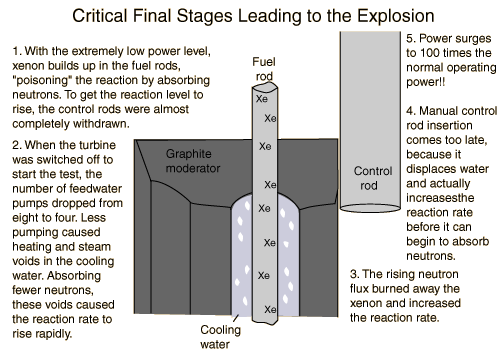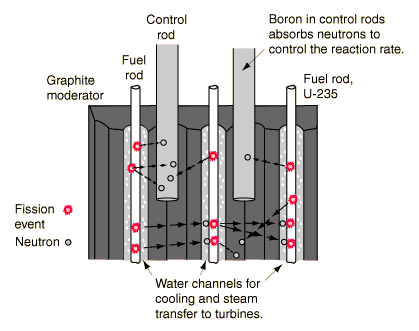A major contribution to the sequence of events leading to the Chernobyl nuclear disaster was the failure to anticipate the effect of "xenon poisoning" on the rate of the nuclear fission reaction in the Chernobyl nuclear reactor.
These neutron are absorbed to control the rate of nuclear fission in a reactor in this case -235U absorbs thermal neutrons in order to fission, and produces other neutrons in the process to trigger other fissions in the chain reaction. In controlling this chain reaction , neutrons are absorbed by the control rods to slow down reaction rates while the moderator slows down fast neutrons to sustain the reaction.
In this fission reaction iodine-135 is produces as a fission product as its next phase of decay, that is into xenon-135. Iodine-135 is a common fission product but has a small probability in absorbing neutrons thus does not significantly affect the reaction. Having a half life of 6.7 hours it decays into xenon-135( having a half life of 9.2hours). Xenon -135 has a very large neutron cross section for absorption, that is approximately 3 million barns comparing to 400 to 600 barns during the uranium fission event.
Under normal operating conditions, the presence of Xenon-135 is controlled by balancing reaction rates. In the sequence to the process, initially Iodine-135 is produced by subsequent decay of Xenon-135 which absorbs neutron and thereby ‘ burned away’ in the established balanced of operating conditions.
Now we come to how all of these influence the subsequent events to the Chernobyl disaster. In a balance operating condition, there is an equilibrium concentration of both iodine-135 and xenon-135 but when the power level was drastically reduced in the Chernobyl reactor, xenon-135.
The person handling the reactor at that point of time tried to increase the power during the time of testing but there was no obvious power increase. He certainly didn’t have a clear understanding that the failure to increase power was due to extensive neutron absorption by the xenon, the apparent thing to do was to remove the control rods to increase reaction and thus power. The increased power then burned away the xenon and also caused voids in the cooling water, both of which rapidly increased the reaction rate, driving it out of control.
This case of ‘xenon poisoning’ of the reaction had been known based on our experience with plutonium producing reactors at Hanford, Washington. In was found the fuel concentration had So the phenomenon had been dealt with from the earliest days of our experience with nuclear fission, and should have been known by anyone who was in control of a nuclear reactor but sadly not in the case of the Chernobyl nuclear disaster.
Core Detail of RBMK-1000 Reactor
Here are some interesting facts on the world‘s worst nuclear power plant disaster and let’s hopefully the last!
Chronology of the Day of Disaster
1. The reactor was powered down for a test sequence to determine if one of the turbo generators could supply power to feed water pumps until standby diesel generators came on line in the case of a local power failure. The test sequence involved the following dangerous steps
a. Instead of the design based 22-32% full power, the power was inadvertently lowered to 1% of full power, an extremely unstable situation because of the positive void coefficient. Edwards reports that the operator failed to reprogram the computer to maintain power at 700-1000 MW(t).
b. Essentially all the control rods were pulled out of the core, to the point where they could not shut down the reactor rapidly if needed. This step was taken to get the power back up, but it only reached 7%, still well below the design parameters for the test. The reason the power could not be brought back up was the "xenon trapping" or "xenon poisoning" effect. Xenon is a decay product of I-135 and is a strong neutron absorber which "poisons" the fission reaction. It reaches equilibrium at normal operating power levels by being "burned away" by neutron absorption and further decay. When the power level was decreased from the 1600 MW level, you had lots of I-135 to decay into xenon, but a small neutron flux with which to burn it away, so it built up rapidly. c. In order to keep the reactor from automatically shutting down under these conditions, they had to disconnect the emergency core cooling system and several of the automatic scram circuits.
d. All eight cooling water pumps were running at the low power, compared to a normal six even at full power, so there was nearly solid water with almost no void fraction, which increased the vulnerability to any power excursion which produced boiling.
2. The turbo generator was tripped to initiate the test, which caused the switching off of four of the eight recirculation pumps. (This would have scrammed the reactor if the automatic scram circuit had not been disconnected.)
3. Reduced coolant flow caused voids to form rapidly in the pressure tubes, increasing reactivity because of the positive void coefficient.
4. Within seconds, with rapidly rising power, an emergency manual scram was ordered, but the almost fully withdrawn rods could not insert negative reactivity fast enough because of their slow speed. Also, an unexpected displacement of water from the control rod tubes occurred, further adding to the positive reactivity.
5. The core went to prompt criticality, overheating and shattering fuel rods and flashing the coolant into steam. Fuel channels were ruptured.
6. Steam pressure blew the 1000-ton steel- and cement-filled biologic shield off the top of the reactor, severing all pressure tubes(some 1600 of them) and exposing the hot core to the atmosphere. Edwards says power reached 100 times operating maximum and the explosive force was about 1 ton of TNT.
Soviet scientist Legasov said of the violations of the safety restrictions "It was like airplane pilots experimenting with the engines in flight." The ORNL review says that if the operators had failed to complete the test they could not have repeated it for a year. This probably influenced them to take more risks than normal.



No comments:
Post a Comment